准备:
1、下载opencv
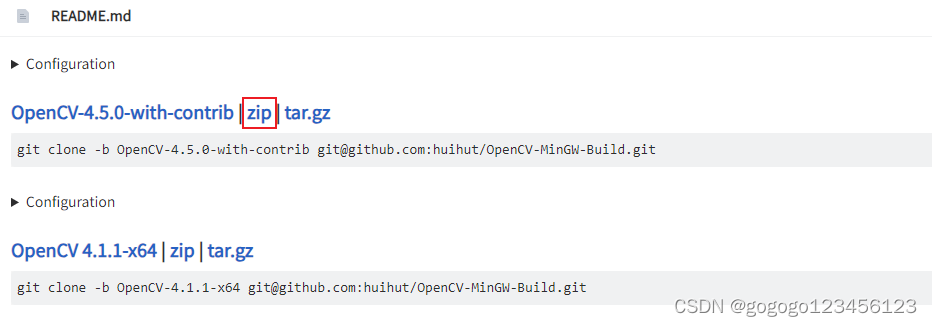
2、下载MinGw
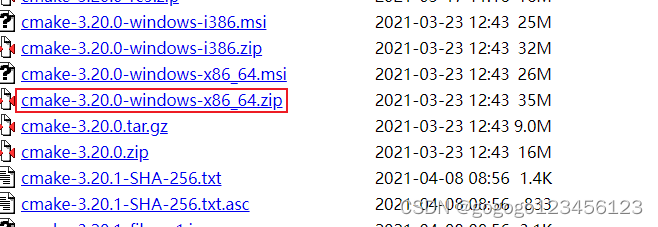 3、
3、
3、下载CMake
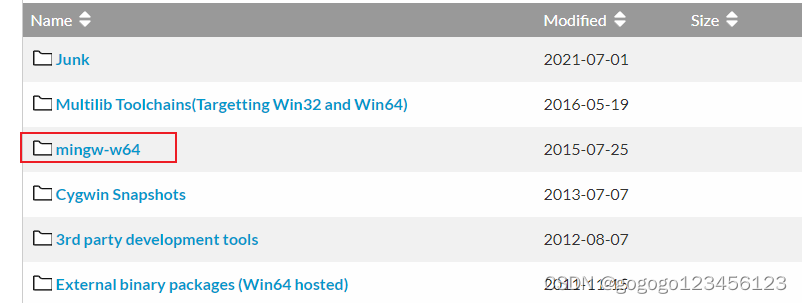
下载完解压放到一个文件夹里面,便于环境管理,文件夹我重命名了,解压出来文件名不一样正常
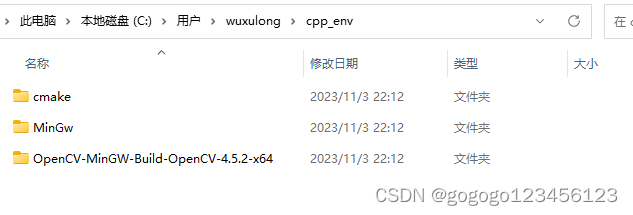
环境变量配置
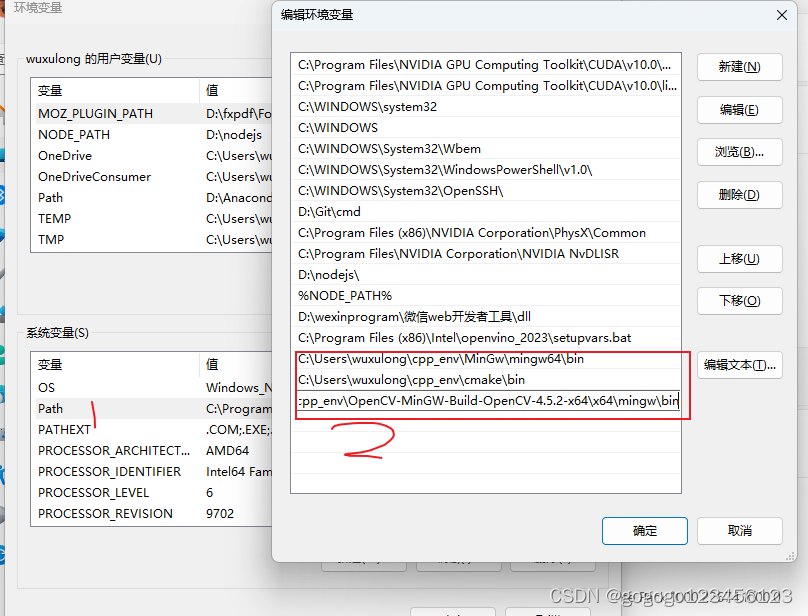
C:\Users\wuxulong\cpp_env\MinGw\mingw64\bin
C:\Users\wuxulong\cpp_env\cmake\bin
C:\Users\wuxulong\cpp_env\OpenCV-MinGW-Build-OpenCV-4.5.2-x64\x64\mingw\bin
4、安装vscode扩展

5、新建main.cpp
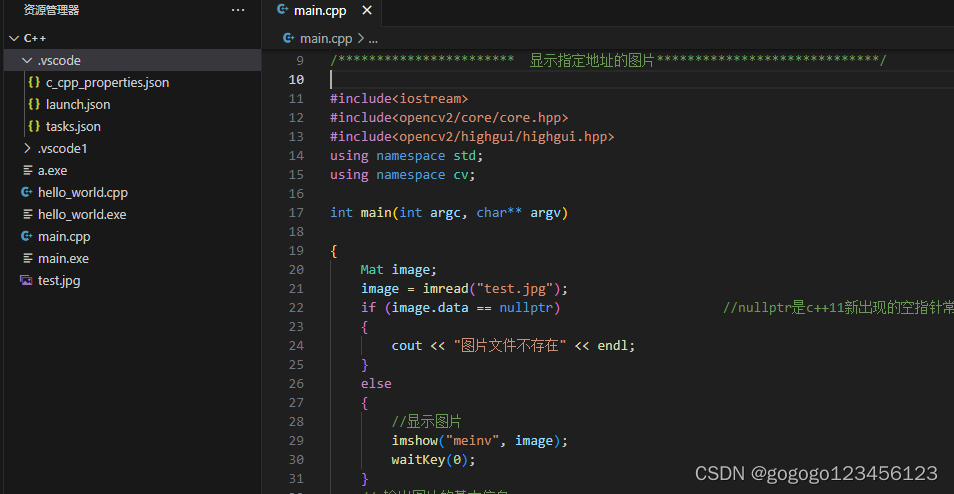
/*********************** 显示指定地址的图片*****************************/
#include<iostream>
#include<opencv2/core/core.hpp>
#include<opencv2/highgui/highgui.hpp>
using namespace std;
using namespace cv;int main(int argc, char** argv)
{ Mat image;image = imread("test.jpg");if (image.data == nullptr) //nullptr是c++11新出现的空指针常量{cout << "图片文件不存在" << endl;}else{//显示图片imshow("meinv", image);waitKey(0);}// 输出图片的基本信息cout << "图像宽为:" << image.cols << "\t高度为:" << image.rows << "\t通道数为:" << image.channels() << endl;// 遍历每个像素//之所以用y这个名字表示行 是因为图片的坐标系中行号就是yfor (size_t y = 0; y < image.rows; y++){unsigned char* row_ptr = image.ptr<unsigned char>(y);for (size_t x = 0; x < image.cols; ++x) {//这是获得像素数据数组的头指针,注意像素数据可能会有多个通道所以才需要用数组存储unsigned char* data_ptr = &row_ptr[x * image.channels()];//对当前像素逐个通道输出颜色值for (int i = 0; i < image.channels(); ++i) {cout << int(data_ptr[i])<<endl;}}}system("pause");return 0;
}
6、新建task.json
{"version": "2.0.0","tasks": [{"type": "cppbuild","label": "g++.exe build active file","command": "C:\\Users\\wuxulong\\cpp_env\\MinGw\\mingw64\\bin\\g++.exe","args": ["-fdiagnostics-color=always","-g",// "-std=c++11","${file}","-o","${fileDirname}\\${fileBasenameNoExtension}.exe","-I","C:\\Users\\wuxulong\\cpp_env\\OpenCV-MinGW-Build-OpenCV-4.5.2-x64\\include","-I","C:\\Users\\wuxulong\\cpp_env\\OpenCV-MinGW-Build-OpenCV-4.5.2-x64\\include\\opencv2","-L","C:\\Users\\wuxulong\\cpp_env\\OpenCV-MinGW-Build-OpenCV-4.5.2-x64\\x64\\mingw\\lib","-L","C:\\Users\\wuxulong\\cpp_env\\OpenCV-MinGW-Build-OpenCV-4.5.2-x64\\x64\\mingw\\bin","-l","libopencv_calib3d452","-l","libopencv_core452","-l","libopencv_dnn452","-l","libopencv_features2d452","-l","libopencv_flann452","-l","libopencv_gapi452","-l","libopencv_highgui452","-l","libopencv_imgcodecs452","-l","libopencv_imgproc452","-l","libopencv_ml452","-l","libopencv_objdetect452","-l","libopencv_photo452","-l","libopencv_stitching452","-l","libopencv_video452","-l","libopencv_videoio452"],"options": {"cwd": "C:\\mingw64\\bin"},"problemMatcher": ["$gcc"],"group": {"kind": "build","isDefault": true//表示快捷键Ctrl+Shift+B可以运行该任务},// "group": "build","detail": "编译器: C:\\mingw64\\bin\\g++.exe"}]
}
7、新建launch.json
{// Use IntelliSense to learn about possible attributes.// Hover to view descriptions of existing attributes.// For more information, visit: https://go.microsoft.com/fwlink/?linkid=830387"version": "0.2.0","configurations": [{"name": "(gdb) Launch","preLaunchTask": "g++.exe build active file",//调试前执行的任务,就是之前配置的tasks.json中的label字段"type": "cppdbg",//配置类型,只能为cppdbg"request": "launch",//请求配置类型,可以为launch(启动)或attach(附加)"program": "${fileDirname}\\${fileBasenameNoExtension}.exe",//调试程序的路径名称"args": [],//调试传递参数"stopAtEntry": false,"cwd": "${workspaceFolder}","environment": [],"externalConsole": false,//true显示外置的控制台窗口,false显示内置终端"MIMode": "gdb","miDebuggerPath": "C:\\Users\\wuxulong\\cpp_env\\MinGw\\mingw64\\bin\\gdb.exe","setupCommands": [{"description": "Enable pretty-printing for gdb","text": "-enable-pretty-printing","ignoreFailures": true}]}]}
8、新建c_cpp_properties.json
{"configurations": [{"name": "Win32","includePath": ["${workspaceFolder}/**","C:\\Users\\wuxulong\\cpp_env\\OpenCV-MinGW-Build-OpenCV-4.5.2-x64\\include",//修改这里"C:\\Users\\wuxulong\\cpp_env\\OpenCV-MinGW-Build-OpenCV-4.5.2-x64\\include\\opencv2"//修改这里// "C:\\Users\\wuxulong\\cpp_env\\OpenCV-MinGW-Build-OpenCV-4.5.2-x64\\include\\opencv2\\core\\core.hpp"// "F:\\Tools\\opencv\\build\\include\\opencv" ],"defines": ["_DEBUG","UNICODE","_UNICODE"],"windowsSdkVersion": "10.0.18362.0","compilerPath": "C:\\Users\\wuxulong\\cpp_env\\MinGw\\mingw64\\bin\\g++.exe",//修改这里"cStandard": "c11",//"cStandard": "c17","cppStandard": "c++17","intelliSenseMode": "gcc-x64"//"intelliSenseMode": "windows-gcc-x64"//"intelliSenseMode": "${default}"}],"version": 4
}
9、运行 快捷键F5
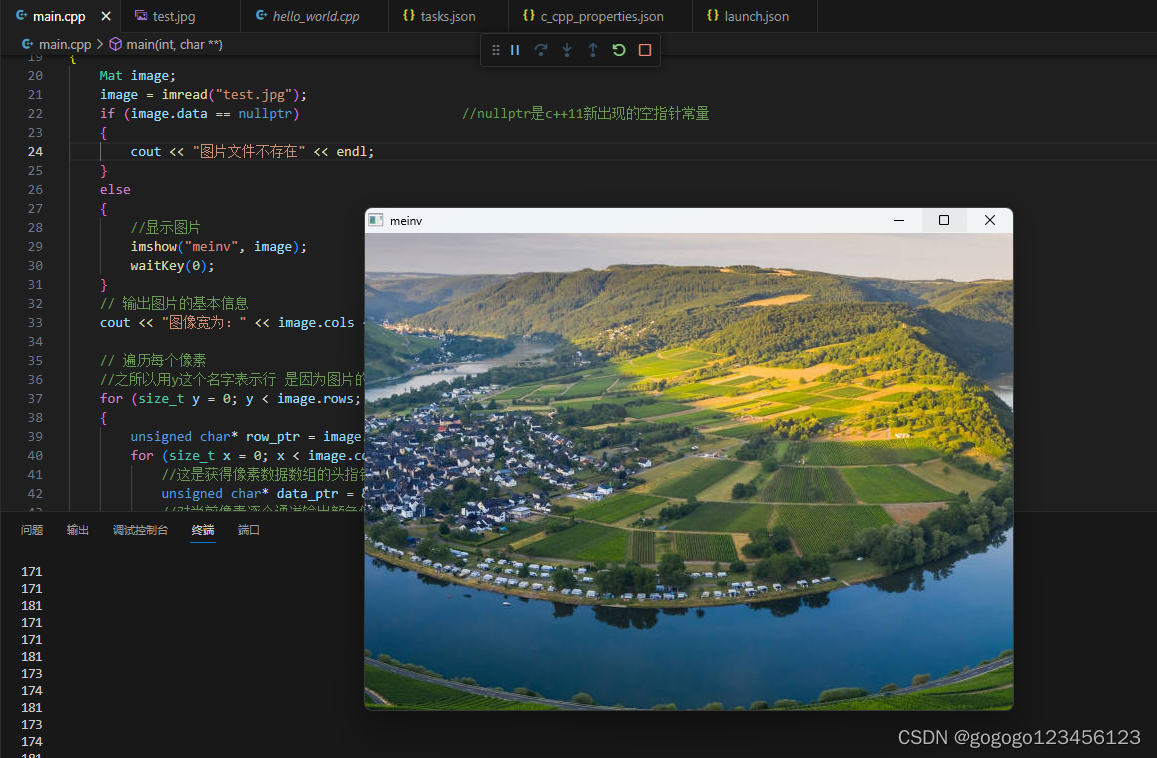

“创新驱动发展·科技引领未来”)



 遍历DataFrame数据行)
)

等级考试一级真题答案解析)










